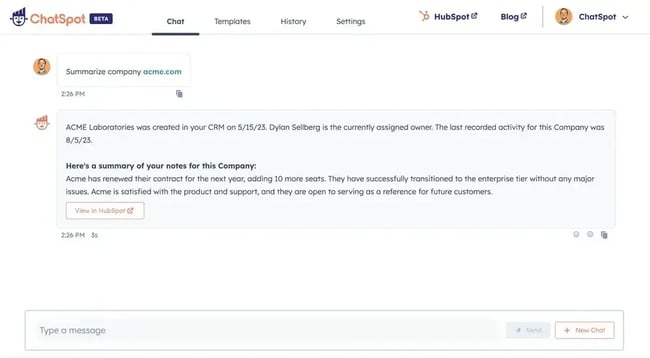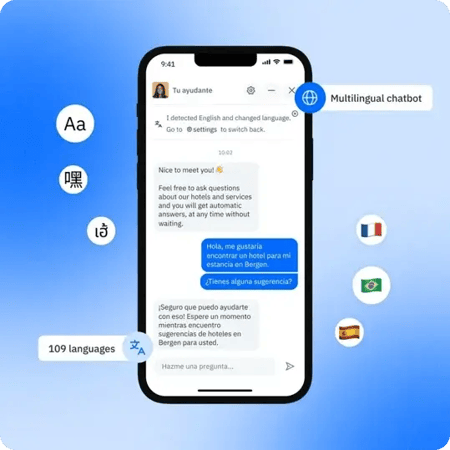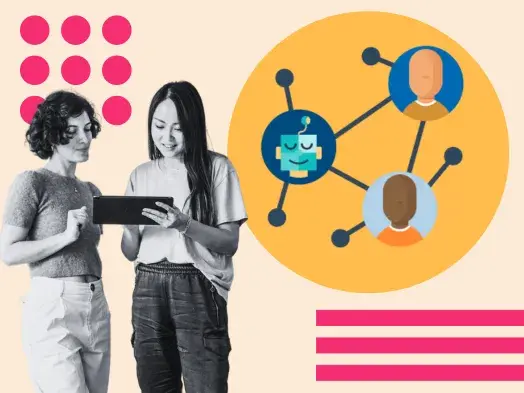Scroll down for 12 unique use cases of conversational AI in customer service as well as nine conversational AI tools that you can start using today.
Table of Contents
- What is conversational AI?
- How can conversational AI benefit service teams?
- 12 Service Use Cases for Conversational AI
- The 9 Best Conversational AI Tools for Service Teams
What is conversational AI?
Conversational AI uses machine learning (ML) and natural language programming (NLP) to figure out how users feel and what they want. It analyzes text and speech to generate human-like responses tailored to the user query.
It’s constantly updating by learning from its interactions and experiences, resulting in improved response quality and processing progressively complex customer requests over time.
Some examples you’ve probably heard of and even used are generative AI agents, chatbots, virtual assistants, voice assistants, text-to-speech software, and speech recognition software.
While the AI market is predicted to grow from $150.2 billion in 2023 to a staggering $1.34 trillion by the year 2030, the conversational AI market is also expected to triple in size by the year 2028. So, it’s time to give it a try.

Its biggest use lies in business operations, especially customer service, because it allows for a natural conversation between the business and its customers without involving CS agents. Thereby, it allows businesses to cut costs, reduce wait times, and increase efficiency in customer service.
Let’s talk more about the benefits.
How can conversational AI benefit service teams?
We’re truly amazed by the pace at which conversational AI is penetrating the market.
Gartner, Juniper Research, and Insider have all reported increased use of smart AI for customer service in several industries, ranging from banking to telecom, and anticipate further use down the line.
The intelligent virtual assistant market size, now at $11.13 billion, is expected to grow to $45.83 billion by 2028 which will make it the fastest-growing segment in the Contact Center forecast along with “global conversational AI,” with a predicted 24% growth in 2024.
So why are businesses increasingly opting for conversational AI?
1. It’s cost-effective.
AI-powered digital assistants and bots handle large volumes of interactions simultaneously, allowing you to cut costs on manpower, office spaces, operational overheads, administrative tasks, utility bills, and resource allocation.
They also offer a higher return on investment. In 2022, Gartner predicted that by 2026, conversational AI will have reduced contact center agent labor costs by $80 billion.
2. It saves time for you and your customers.
With AI, there's no more sitting around and waiting for reps to call you back. Empower your customers to find answers on their own — saving time on simple questions and helping customers find basic info, like FAQs, lessons, and guides, quickly.
For complex or technical inquiries, AI makes sure customers get help fast by sorting and sending queries to the right specialists.
3. It’s available 24/7.
One of the most attractive features of any AI tool is its consistency. AI works 24/7. No rest or breaks required.
This is especially helpful for businesses with a global reach. Your staff doesn’t need to be working round the clock. Instead, AI can handle things at all hours of the day, ensuring your customers get assistance whenever needed.
4. It increases efficiency.
AI removes engagement and language barriers by providing consistent and accurate information to customers, minimizing the risk of human error and identifying product issues before they arise.
“AI can help highlight product issues before they’re vocalized by users — meaning you can solve problems before they even arise,” says Gero Keil, Co-founder and CEO of Levity
Your sales and marketing customer service teams can automate and monitor cross-selling and upselling campaigns or simply manage client accounts more efficiently.
5. It aids in deeper insights and personalization.
Want deeper insights into your consumers?
Use online data like previous messages, past behavior, past purchases, and other details (like demographics, location, and trends) to spot trends in customer behavior and preferences.
Conversational AI tools have advanced analytics options that can analyze positive and negative sentiments. You can then act on the data to provide customized recommendations or solutions to each customer.
In our 2023 State of AI Survey, 64% of service reps who use AI today said it enables more time to personalize and improve upon the responses they give to customers.
12 Service Use Cases for Conversational AI
Most customer service operations can be efficiently executed using AI-powered chatbots, virtual assistants, AI-powered interactive walkthroughs, and voice assistants, minimizing costs and leaving your service team to focus on more important things.
From onboarding clients to customer service, technical support, and even sending reminders, arm your hard-working service reps with AI to offer unparalleled customer service and meet all customer expectations.
Here are 12 real-life examples of implementing conversational AI in customer service.
1. Self-support
Deploy voice-based virtual assistants to empower customers to self-serve. Customers can onboard themselves, resolve their problems, and manage their accounts at their own pace.
For example, McAfee, a company that provides anti-virus services to companies, has deployed AI-powered voice bots that allow for customer self-service. These voice bots offer seamless interaction, leading to a 74% auto-resolution rate through self-service and a 75% boost in productivity for customer assistants.
2. Account Management
You can also manage account-related tasks like account creation, password resets, account updates, account linking and integration, and account deletion or deactivation using a conversational AI interface.
Capital One’s customers use Eno for answers to queries, help balance checks, and pay credit card bills. Eno is accessible to users via its website, app, and even smartwatches.

3. Ordering System
Why manually take orders when you can train your AI assistant to take them for you?
Starbucks uses a conversational AI tool, My Starbucks Barista, that allows customers to place, modify, and pay for their orders using voice commands. Customers can even reorder their favorite items with a feature named Starbucks Reorder Skill.

See how it works in action:
4. Accessibility Services
AI can also improve the quality of customer support for people with disabilities, ensuring inclusive experiences. Examples include text support for the hearing-impaired, voice support for the visually impaired, language translation, and simple language for cognitive disabilities.
Bank of America uses advanced AI to improve accessibility for all customers, including those with disabilities. Its virtual assistant, Erica, provides tailored financial guidance to users, including those with accessibility needs.

To support visually impaired users, Erica includes Americans with Disabilities Act (ADA) tags, helping them navigate different app sections. Erica’s voice will automatically be disabled so they don’t conflict.
Over 32 million customers have engaged with Erica since its release, making it one of the most popular AI tools in the US.
5. Reservation and Booking Assistance
Going for a vacation?
No more need to call numerous hotels and venues and wait for availability information or vacancies. Easily reserve, book, and pay for a hotel with conversational AI.
Resorts World Las Vegas uses Red to delight its guests. Red is a digital concierge skilled in providing excellent guest service.

It takes care of everything at the Resorts World Las Vegas call center, allowing guests to get assistance from Red anytime. For instance, Red can help you with dinner reservations, show ticket purchases, room service orders, wake-up calls, and more.
Red handles over 38,000 conversations monthly and adeptly resolves over 1,000 frequently asked questions, making CX easier and guest experiences smoother.
6. Authenticating Customers
Smart AI uses techniques like voice biometrics and recognition to swiftly and naturally verify customer identity, enhancing security and convenience.
In 2021, HSBC UK announced that its voice biometrics system prevented almost £249 million of customer funds from fraudsters, resulting in a 50% decrease in attempted fraud compared to the previous year.

7. Payment Reminders for Customers
AI can also be used to automate and send timely voice reminders to customers about upcoming payments.
By simply automating reminders, you reduce the risk of missed payments, improve customer adherence to payment schedules, and enhance overall payment efficiency without ever having an agent go on a call.
Plus, 62% of consumers prefer talking to a chatbot over a human agent (sorry, humans).
Curious how voice AI works? Check out this video:
8. Intent Detection
Detect customer intent by analyzing customer emails, messages, calls, and surveys to understand the purpose behind customer queries. This allows for customized responses and solutions.
Take Google’s Dialogflowintent detection, for instance — a natural language processing tool that uses intent detection to understand the intent behind the queries. Furthermore, it allows your business to build interactive and intelligent chatbots and virtual assistants.
.webp?width=650&height=324&name=google%20intent%20detection%201%20(1).webp)
While a human agent may struggle with handling a frustrated or worried customer, your chatbot will adopt an empathetic tone toward them and stay patient every step of the way.
Vodafone’s TOBi is an AI tool that does exactly that.
It’s so effective that since its launch in April 2021, 70% of customer queries have been resolved through TOBi, with a mere 30% being forwarded to agents. 🤯

9. Multilingual Support
Expand your customer reach to a global audience with AI-powered multilingual support. It lets customers interact in their preferred languages, breaks language barriers, and ensures a more accessible experience.
Airbnb uses multilingual support in its chatbot to assist users in 31 different languages in booking accommodations, addressing inquiries, and offering support.

10. Guidance
Conversational AI can help users troubleshoot faster by guiding them through issue diagnosis and resolution. AI offers step-by-step, easy-to-follow instructions, reducing response times and enhancing customer satisfaction.
Lemonade’s insurance chatbot, Maya, is a helpful companion who guides users when they're buying insurance. Maya makes the process easier and more understandable for people.
11. Crafting Emails and Content Creation
Handling client accounts can be time-consuming and tedious. Half the time, your service team is sending customers emails or replying to them.
With ChatSpot by HubSpot, agents can increase their performance by 10x. ChatSpot is a content assistant that helps you ideate, create, and share remarkable content in a flash.
ChatSpot uses your company’s CRM data to help with customer service and is tailor-made for growing businesses. It is free for everyone, even if you aren’t yet using the HubSpot CRM.

Begin Your Conversational AI Experience With HubSpot's AI Tools Now
12. Feedback Collection
Manual feedback collection requires exhaustive planning, long hours, and a labor force. It can also cost you an arm and a leg.
With smart AI, you can automatically gather customer feedback, opinions, and insights by engaging customers in interactive conversations. This helps service teams understand customer experiences, identify areas for improvement, and make data-driven decisions to enhance products, services, and overall customer satisfaction.
Haptik Chatbot interacts with customers for queries and issue resolution. At the end of each conversation, the bot guides customers through feedback survey forms and gathers valuable insights.

The 9 Best Conversational AI Tools for Service Teams
1. ChatSpot by HubSpot CRM
ChatSpot by HubSpot CRM is your AI-powered sales and marketing assistant designed to aid business growth. It combines the power of ChatGPT with unique data sources, including HubSpot CRM.
ChatSpot empowers service teams to manage conversations effectively, streamline communication, and provide personalized support. If yours is a growing business, then ChatSpot is for you.
Core Features
- Blog builder and landing page builder
- Conversations inbox
- Chat channel setup
- Reply editor
- Conversation assignment
- SuccessClose conversation
- Change channels in the reply editors
Pricing: ChatSpot is free for everyone, even if you’re not using the HubSpot CRM.
Best for: Service teams, sales professionals, and marketing teams within growing businesses looking to streamline their operations and enhance customer interactions.
What we like: It’s free for everyone, even those not using HubSpot CRM. It’s designed to seamlessly integrate with your existing workflow, helping generate blog posts, emails, and social media content in a flash. It executes tasks and manages contacts using natural language.
2. Zobot by Zoho CRM

Zobot is a part of Zoho SalesIQ's chatbot platform and is a user-friendly, codeless, drag-and-drop chatbot builder. It makes it easy to create AI chatbots to automate live chat interactions. For those with coding skills, Zobot also offers a programming interface to enable advanced automation possibilities.

Zobot is compatible with various AI technologies, including IBM Watson, Dialogflow, Microsoft Azure, Haptik, and Zia Skills, enabling seamless integration. By using Zobot, service teams can answer customer queries, automate responses, and provide instant assistance.
Core Features
- Self-service platform
- Codeless drag-and-drop chatbot builder
- Integration with top AI technologies
- Hybrid chatbot capabilities (combining guided flow and AI)
- Programming interface for custom bot development
Pricing: Zobot’s pricing structure offers a lot of flexibility. Pricing considerations include the number of chatbots, concurrent user support, and access to advanced features. Their Standard plan starts at $20 a user per month when billed annually. It comes with a free trial and a free version.
Best for: Retail, ecommerce, real estate, financial businesses, and technology companies.
What we like: You can create AI chatbots effortlessly using a code-less chatbot builder and integrate them with your existing AI technologies like IBM Watson, Dialogflow, and more. Develop hybrid chatbots by combining guided flow and AI capabilities. Use your knowledge base for chatbot training.
G2 score: 4.3
Capterra score: 4.3
3. Revenue Digital Assistant (RDA) by Coversica

Conversica’s intelligent virtual assistants (IVAs) engage with your leads, prospects, customers, and employees through email, SMS text, and website chat.
With language support in multiple languages, including English, French, German, Spanish, Portuguese, and Japanese, Conversica’s technology mimics honest human dialogue to drive engagement and revenue growth.
Core Features
- Insights-driven conversations
- Feedback collection and analysis
- Proactive customer engagement
- Renewal initiation
- Personalized email marketing
Pricing: The pricing for Conversica starts at $2,999 per month, and they also provide a free demo with a free version to show you how it works.
Best for: Sales, marketing, and customer success teams in most verticals, including technology, telecommunications, insurance, automotive, and hospitality.
What we like: It integrates with over 50 business tools, including CRM and marketing platforms. It uses data enrichment and context generation for personalized exchanges, and engaging contacts through email, SMS, and website chat. Its multi-language support helps companies who need to support diverse customer interactions.
G2 score: 4.5
Capterra score: 4.5
4. Lyro by Tidio

Lyro by Tidio is an AI-powered customer service agent built to help growing businesses automate support and deliver instant, human-like responses. Unlike traditional chatbots, Lyro uses conversational AI to understand customer intent, provide accurate answers, and resolve up to 67% of repetitive inquiries without human involvement.
Its real-time support works across multiple channels and integrates seamlessly with Tidio’s live chat, ensuring smooth handoffs when complex cases require a human touch. Lyro learns continuously from your knowledge base and FAQs, keeping answers up to date and on-brand.
Core Features
- Conversational AI trained on FAQs
- Multilingual support
- Smooth human handoff with live chat
- Automated responses for up to 70% of inquiries
- Proactive messaging to boost conversions
Pricing: Free plan available; paid plans start at $24.17/month.
Best for: Ecommerce, SaaS, startups, and SMBs that need scalable, affordable AI-powered support.
What we like: Lyro makes advanced AI accessible to small and mid-sized businesses. It handles FAQs, product inquiries, and order tracking while reducing agent workload. The combination of multilingual support and easy integration makes it ideal for global online stores.
G2 score: 4.7
Capterra score: 4.8
5. Netomi

Netomi is an advanced platform designed to provide your enterprise-level businesses with an innovative solution for automating and upgrading your customer support operations.
Unlike other chatbots, Netomi uses smart AI and deep learning technology to deliver an enhanced customer experience. Its real-time support is available on various support channels.
Core Features
- Generative AI
- Email resolution
- Webform automation
- Omni channel integration
- Auto-pilot and co-pilot modes
Pricing: Prices are available upon request.
Best for: Ecommerce, entertainment, fintech, SaaS, telecom, travel & hospitality
What we like: Netomi offers multi-channel support, including web chat, messaging, SMS, and voice, with native integration with leading platforms like Zendesk Chat. It offers customer support in over 100 languages for a global reach.
It provides automation of repetitive customer questions through chatbots and immediate access to hyper-relevant articles from the knowledge base.
G2 score: 4.8
Capterra score: 5
6. Jetlink

Jetlink can be the new front line for your customer service, allowing your business to deliver personalized experiences on a large scale. Clients love its easy-to-use interface and its low-code/no-code approach. You can refine customer service, reduce churn, and drive revenue.
Core Features
- Low-code/no-code chatbot options
- Enterprise-level chatbot capabilities
- 24/7 availability
- Cost-effective scalability
- Seamless omnichannel integration
Pricing: Prices are available upon request.
Best for: Banking, automotive, pharmaceuticals, FMCG, retail, financial services, insurance, telecommunications, utilities, ecommerce, and more.
What we like: Jetlink engages customers with dynamic messages, including text, buttons, and images, while connecting to backend services for dynamic answers. It provides insights driven by feedback analysis and seamless integration with CRMs. Jetlink offers insights into chatbot performance, enabling data-driven decisions for enriching customer interactions and outcomes.
G2 score: 4.9
7. AI Chatbot by Haptik
.webp?width=450&height=768&name=haptik%20(1).webp)
With the evolution of AI chatbots into Intelligent Virtual Assistants (IVAs), Haptik offers contactless shopping experiences and interactions via web, app, WhatsApp, and other channels.
Core Features
- Drag-and-drop interface for creating chatbots
- 24/7 functionality
- Real-time issue resolution
- Generative AI
- Hybrid AI & live agent system
Pricing: Haptik pricing starts at $5,000 per year.
Best for: Ecommerce, retail, travel and hospitality, telecom, mortgage financial services
What we like: Haptik’s chatbot is scalable and offers personalized solutions using sentiment analysis. It measures the effectiveness of AI chatbot interactions and improves accordingly.
Also, it integrates with Messenger, WhatsApp, Gila CMS, Freshdesk, Meta for Business, Instagram, Shopify, and Zendesk Suite.
G2 score: 4.5
Capterra score: 4.4
8. Kindly AI
Kindly offers a powerful conversational AI solution tailored for businesses engaging with online shoppers and buyers. Kindly offers conversation optimization and customization, redefining how brands connect with their audience.
Core Features
- Guided buyer journey
- Conversion optimization
- Cart abandonment tools
- 24/7 website support
- Customizable and ready-to-use chatbots
Pricing: Prices are available upon request.
Best for: Mid-market to enterprise companies such as textile manufacturers, ecommerce retailers, financial institutions, and healthcare providers.
What we like: Kindly AI uses behavioral data and engagement metrics to drive growth. It offers expert advice for leveraging AI chatbots and building effective conversational strategies and helps reduce the “abandoned cart” issue. It integrates with third-party platforms like Slack, HubSpot, Zendesk, and Facebook Messenger.
G2 score: 4.9
Capterra score: N/A
9. Happyfox

Happyfox offers a comprehensive live chat software solution to deliver real-time support and drive up engagement with quick responses and customized solutions. It effortlessly integrates with third-party applications.
Core Features
- Categorized chats by departments
- Ticket and case management
- Customized chat widgets
- Feedback collection and analysis
- Web and mobile accessibility
Pricing: Happyfox pricing starts at $29 a month with unlimited agents and 500 chats.
Best for: Ecommerce, education, travel, lawyers and law firms, real estate.
What we like: Happyfox offers a customizable chat widget to match your brand’s look and feel. It also integrates with Salesforce CRM, Zoho, Highrise, and SugarCRM. It initiates chats automatically based on specific conditions like time spent on a page or multiple page visits. It also collects and analyzes feedback for performance improvement.
G2 score: 4.4
Capterra score: 4.6
Step into the future: Empower your service team with conversational AI!
If you haven’t already employed conversational AI to assist your service teams and your customers, do it now and do it fast. With so many awesome AI tools available (and getting better each day), you’ll cut your costs while driving up efficiency.
Chatbots




.png?height=613&width=1920)


![How Consumers Use Live Chat for Customer Service [New Data]](https://53.fs1.hubspotusercontent-na1.net/hubfs/53/live%20chat%20for%20customer%20service_featured%20image.jpg)

![What is Proactive Live Chat? [+ How to Implement It and 7 Tools]](https://53.fs1.hubspotusercontent-na1.net/hubfs/53/proactive%20live%20chat%20examples.jpg)
![Do Consumers Prefer to Talk to Chatbots or Humans for Service Needs [New Data]](https://53.fs1.hubspotusercontent-na1.net/hubfs/53/CHATBOTS%20(1).jpg)

